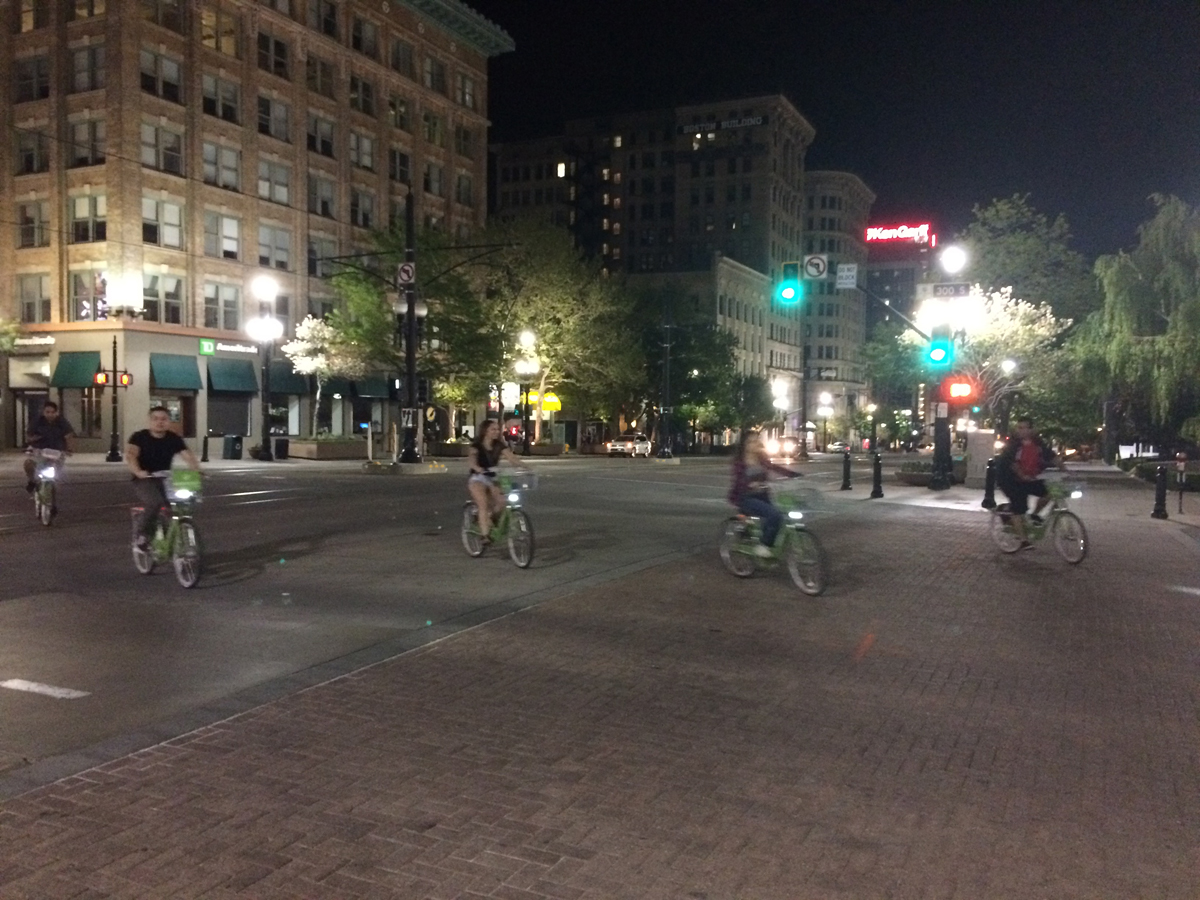By Charles Pekow
Sometimes 1 + 1 equals one. 1 mountain biking mecca outside town + one good on-street bike lane system with a phenomenal bike-to-work percentage in town = one combined Silver Bicycle Friendly Community (BFC). The City of Moab and surrounding Grand County jointly applied to the League of American Bicyclists (LAB) for designation as a BFC. Cyclists don’t necessarily end their trips where government jurisdiction changes and the city and county effectively work together to advance all forms of cycling. So the combined application worked in their favor.
“Regional planning is very important. We like to see shared applications,” says Nicole Wynands, LAB’s BFC program manager. “Usually, cities do better than counties but here the county has a lot to offer.”
Indeed, the Moab Trails Alliance and Trail Mix Committee “have been doing a heck of a lot of good things inside the city and outside the city limits,” so a combined application made sense, notes David Olsen, Moab community development director.
The city also took the county trail plan and adopted it as its own.
But the city and county each know their strengths. The Moab Area Travel Council gets right to the point: the opening paragraph on its website states “(l)et Moab be your base camp for world famous mountain biking…” and later invites people to try its multitude of trails suitable for all levels of riders.
And when people aren’t mountain biking around Klondike Bluff or elsewhere, they’re likely to be biking to or from work in the city. LAB praised Moab for its amazing 7.6 percent of workers who commute by bike, considering that the national average is only .55 percent. (Of course, it’s easier to get a big ratio in a small town where fewer people live far from work.)
Additionally, LAB praised the city and county for sponsoring bike events, ample bike parking and Safe Routes to School (SRS) programs in all schools. Some stores even give free coffee if you bike to work.
So why didn’t they receive a higher rank (gold, platinum, yet-to-be-reached-by-anybody diamond)? What they’ve done is good enough to get there in the areas they’ve worked on “but they are not fulfilling other requirements. They have the potential because they have such a strong bike culture,” Wynands explains.
While Moab has created plenty of bike lanes, it hasn’t put them in key places on main roads and some aren’t up to standards, LAB judges noted. “We are very concerned about safety on the roads. If the city addresses that issue, it can get more people riding,” Wynands suggests. “They really need to get kids to school safely” and make roads safer for less skilled cyclists.
LAB also noted that while the city provides plenty of parking, the racks don’t all meet LAB’s recommended standards.
As to LAB’s suggestions, Olsen notes that the main drag through town, US 191 is in state, not local hands. To provide bike lanes, “they’d have to replace parking or reduce a lane or two. They won’t do that.” Olsen says he doesn’t agree that the parking facilities aren’t adequate. But he acknowledges that “half the people do and half the people don’t like to lift their bikes up” to use the racks at Dead Horse Point State Park, where people come to ride the popular Intrepid Trail System.
Meanwhile, the City of Orem applied and didn’t quite make BFC status this year but got an Honorable Mention, one of 18 American communities to achieve that status this year. (Nine applicants got nothing, Wynands says).
The judges were impressed with Orem’s low speed limits, road guides, Bike Month celebration, bicycle master plan and good SRS program. Its 1.6 percent bike-to-work share is treble the national average. The 34 miles of bike lanes “is pretty good” for a town of about 91,000, Wynands says. LAB likes the ordinance requiring bike parking for all new development.
Just in May, the city celebrated the opening of the Murdock Canal Trail and the mayor enthusiastically participated in a Bike to Work Day event.
“If they actually did something in all categories, they could easily get bronze (the level between honorable mention and silver) but they don’t do much encouragement and education beside SRS and we want to see a good amount of effort in all categories,” Wynands explains.
She also complained that “none of the bike lanes are on arterial streets. They may have them on low-traffic streets that may not need bike lanes. The ones that go places are the ones that need bike structure.”
The town has made great strides in the last few years, says Paul Goodrich, Orem’s transportation engineer. It started a plan in 2010 and more than 1,000 people participated in some way, mainly responding to requests to suggest infrastructure improvements. In two years, the town trebled the number of bike lanes from 11.6 to 34.2 miles. The city is planning to connect them, Goodrich adds. “We have a lot of bicycle advocates on the Transportation Advisory Commission.”
He states that “the only thing keeping us from moving any faster than we are moving are the budget constraints. We have had to do attrition on city staff. We have gone down from 18 to eight in engineering alone,” as about 50 positions were cut. “I’d love to have a bicycle planner on staff or an intern or somebody to help me. But it is one of those things when you have that much attrition and people expect the same level of service.”
Goodrich hopes the state can fill in some of the infrastructure and education components that the city can’t afford.






